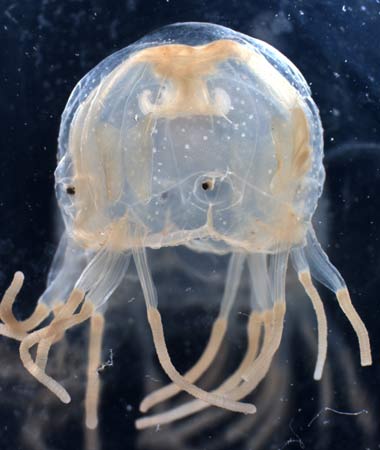How Deadly Is the Box Jellyfish?

By all accounts, 10-year-old Australian girl Rachael Shardlow should be dead. One of the world’s most poisonous creatures, a box jellyfish, stung Shardlow in Australia in December, the Australian Broadcasting Corporation reported. After being pulled from the water with tentacles still wrapped around her legs, she amazingly lived through the attack. Her survival has baffled doctors and marine biologists, as even a miniscule amount of jellyfish venom can cause the heart to seize up and stop.
While no official tallies exist, anecdotal evidence suggests dozens of people and perhaps more than 100 or more die each year from the many species of box jellyfish that exist in all oceans.
[Takeover! See Stunning Photos of Jellyfish Blooms]
Some 20 to 40 people die from stings by box jellyfish annually in the Philippines alone, according to the U.S. National Science Foundation. "But because death certificates are not required in many countries within the range of box jellyfish, worldwide fatalities from box jellyfish may be seriously underestimated," the NSF states.
Box jellyfish, a class that includes 50 described species, have tentacles covered in tiny biological booby traps known as cnidocysts. Each cnidocyst contains a tiny dart and a load of poison that cause “the most explosive envenomation process that is presently known to humans,” according to a 1988 paper in The Medical Journal of Australia.
Once the dart pierces the skin, the cnidocyst shoots the toxin through the needle and into the victim. The toxin then enters the blood, where it can cause a dangerous spike in blood pressure, stop the heart, and kill the victim, a team from Monash University in Melbourne, Australia, wrote in a 2005 paper in the journal Toxicology Letters.
Unlike other jellyfish, box jellyfish are agile swimmers, a skill scientists say possibly arose because one set of their 24 eyes detects objects that get in their way.
Sign up for the Live Science daily newsletter now
Get the world’s most fascinating discoveries delivered straight to your inbox.
[How Box Jellyfish Use Their 24 Eyes]
Larger jellyfish are generally more dangerous than smaller ones because they harbor more cnidocysts. However, all jellyfish contain some poison, and in fact the phylum that all jellyfish belong to, Cnidaria, is named after their poison-producing structures.
Follow Live Science @livescience, Facebook & Google+.









